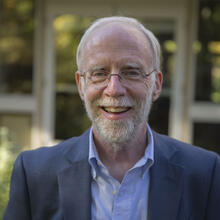Cambridge, MA. As readers will know, I am meditating with you on “The Bhagavad Gita in Lent” and more practically, I am also teaching a seminar on the Gita this semester, for about 20 students. We are this week reading Chapter 3 (yes, third chapter, and the semester is at least half over!), on detached action, action as a sacrifice and service for the sake of the world, and hardest of all, action as what happens by way of nature and time and providence, our selves not really the doers of “our” actions.
The person who is attached to his self only, who is contented in his self, and is pleased with his self, has nothing to do. He has no interest at all in what is done, and none whatever in what is not done, in this world; nor is any interest of his dependent on any being. (Gita 3.17-18; Talang translation, slightly adapted)
But this utter detachment — when the bond between self and action is severed — does not lead to inertia, or flight from the world. Rather, it is a path of serene action, for the sake of the world, and leading directly to God:
Therefore always perform action, which must be performed, without attachment. For the person who performs action without attachment attains the Supreme. (Gita 3.19)
Later in the chapter, Krishna says,
Dedicating all actions to me with a mind knowing the relation of the supreme and individual self, engage in battle without desire, without (any sense of) “mine,” and without any mental upset. Those who always act on this opinion of mine, full of faith, and without carping, are released from all actions. (Gita 3.30-31)
Such people, on whom the world depends if it is to run smoothly at all, are at rest, actionless, even in the busiest of moments. They are busy all the time, but always at rest too – as last week, “The self-restrained person is awake, when it is night for all beings; and when all beings are awake, that is the night of the right-seeing sage.” (Gita 2.69)
Perhaps oddly — but by now readers will see the intuitive logic of this Lenten series — I am reminded here of Jesus’ utter detachment as he faces the growing conflict around his mission, and yet serenely and with power contemplates laying down his life and picking it up again. One again, it is in the Gospel according to John that we see the greatest resonance to this dimension of the Gita, since John’s Jesus is ever at least, no matter what happens. In Chapter 10, after conjuring the image of the good shepherd, Jesus says this:
For this reason the Father loves me, because I lay down my life in order to take it up again. No one takes it from me, but I lay it down of my own accord. I have power to lay it down, and I have power to take it up again. I have received this command from my Father.’ (John 10.14-18)
Or in Chapter 5:
I do nothing on my own. As I hear, I judge; and my judgment is just, because I seek to do not my own will but the will of him who sent me. (John 5.30)
The work of Jesus happens; it is in accord with the will of God. Naturally and rightly, today we value the struggle of Jesus, his human fears and desires, how terrible a moment his passion and death must have been for him. But there is a power to this alternative insight, which John insists on putting before us: Jesus takes up his life, he lays it down. God’s great plan is unfolding, and by his simple and clear attentiveness to the present moment, Jesus sees where everything is heading. There are no surprises, and even in his Passion – in his passion – Jesus stands detached, allowing his Father’s plan to unfold. The end is clear in the beginning; all this will happen while I, Jesus, observe it happen.
We cannot simply make this happen for us. Both the Gita and John make clear that this is no light venture. The Gita warns against giving the wrong impression to people who need to keep busy:
A wise person should not shake the convictions of the ignorant who are attached to action, but acting with devotion (himself ) should make them apply themselves to all action. (Gita 3.26)
Let us try, then, as we look all the more closely at Jesus in these last weeks of Lent, as he approaches Jerusalem, to be as quiet as he is. The greatest and tumultuous things in our lives can be, if we understand this, as simple as the rising and setting of the sun; we just need to be there, we don’t have to do anything.
Or so it should seem, once in a while in Lent.







